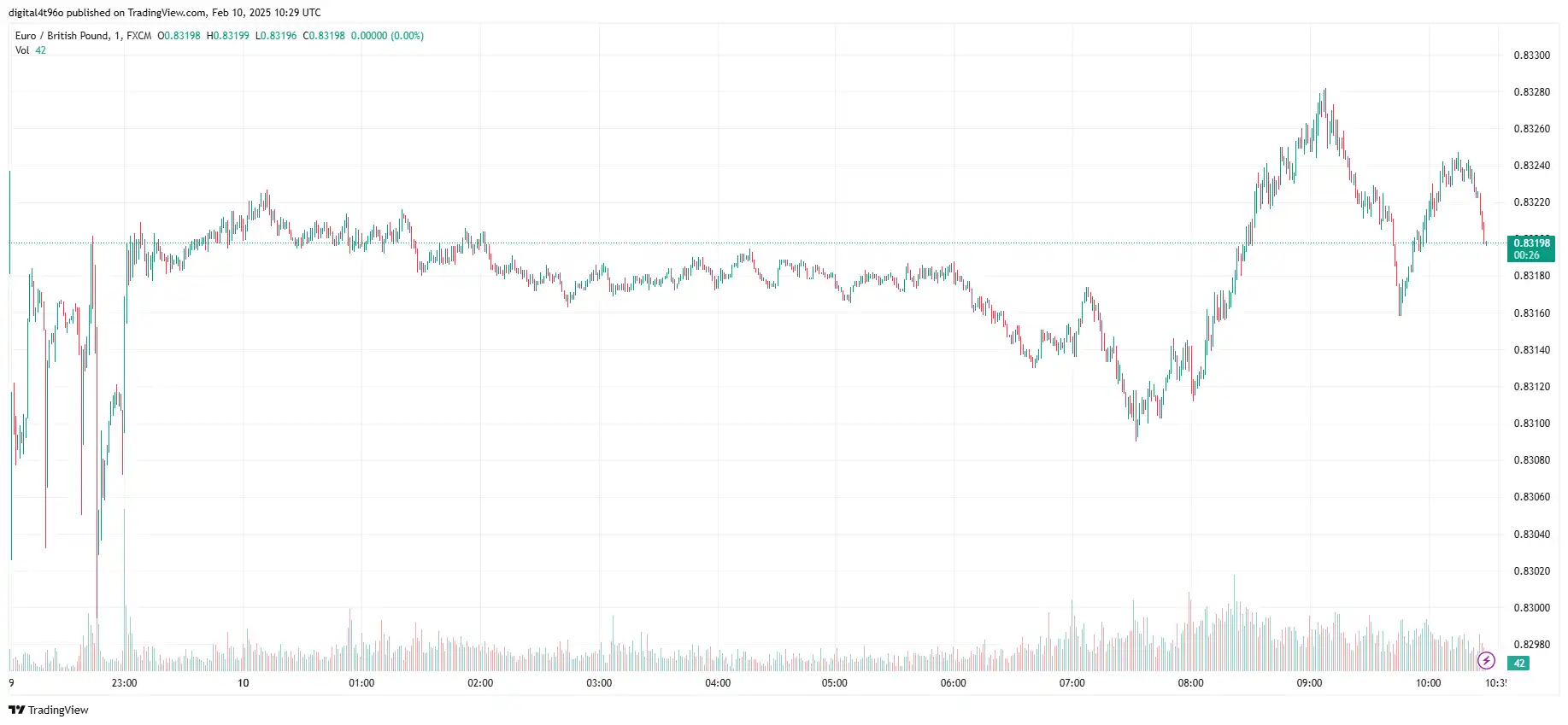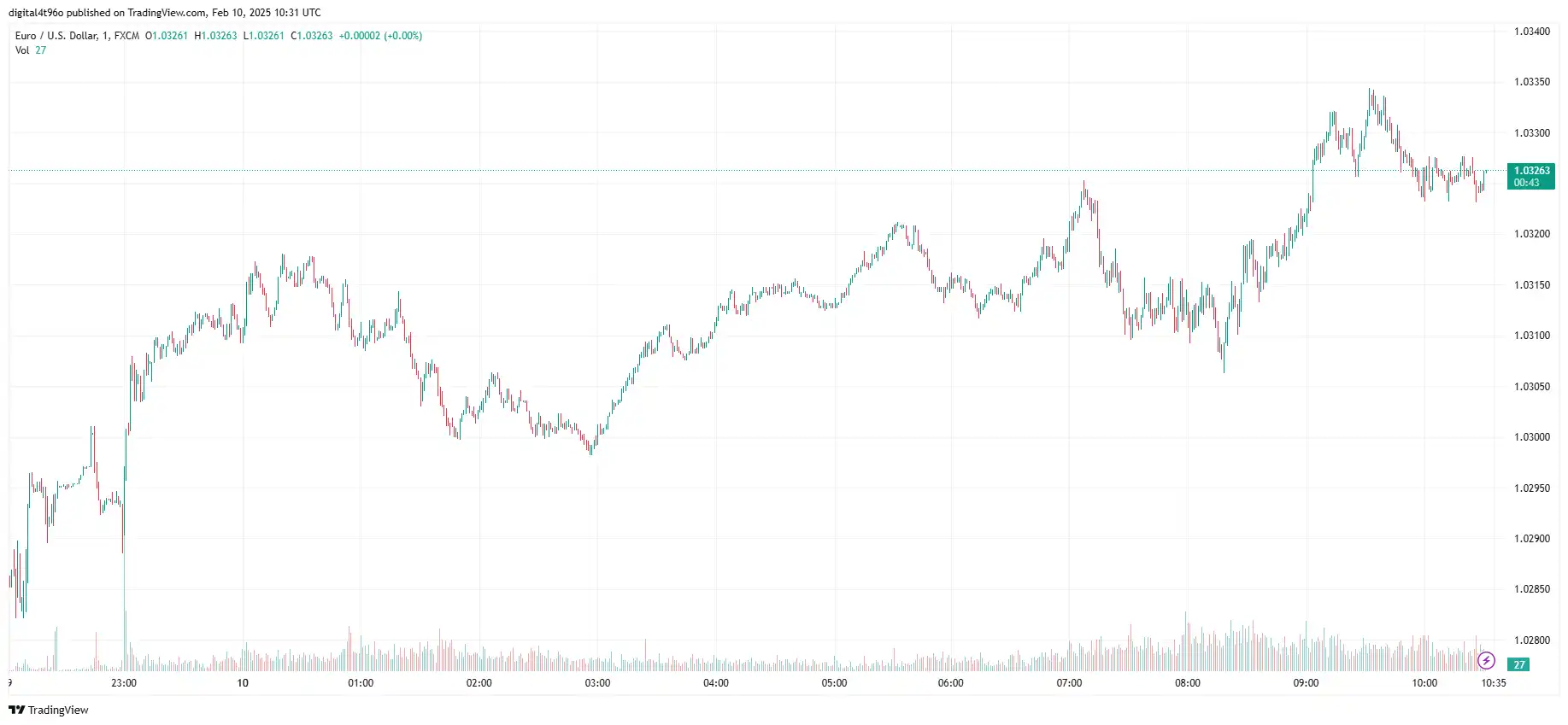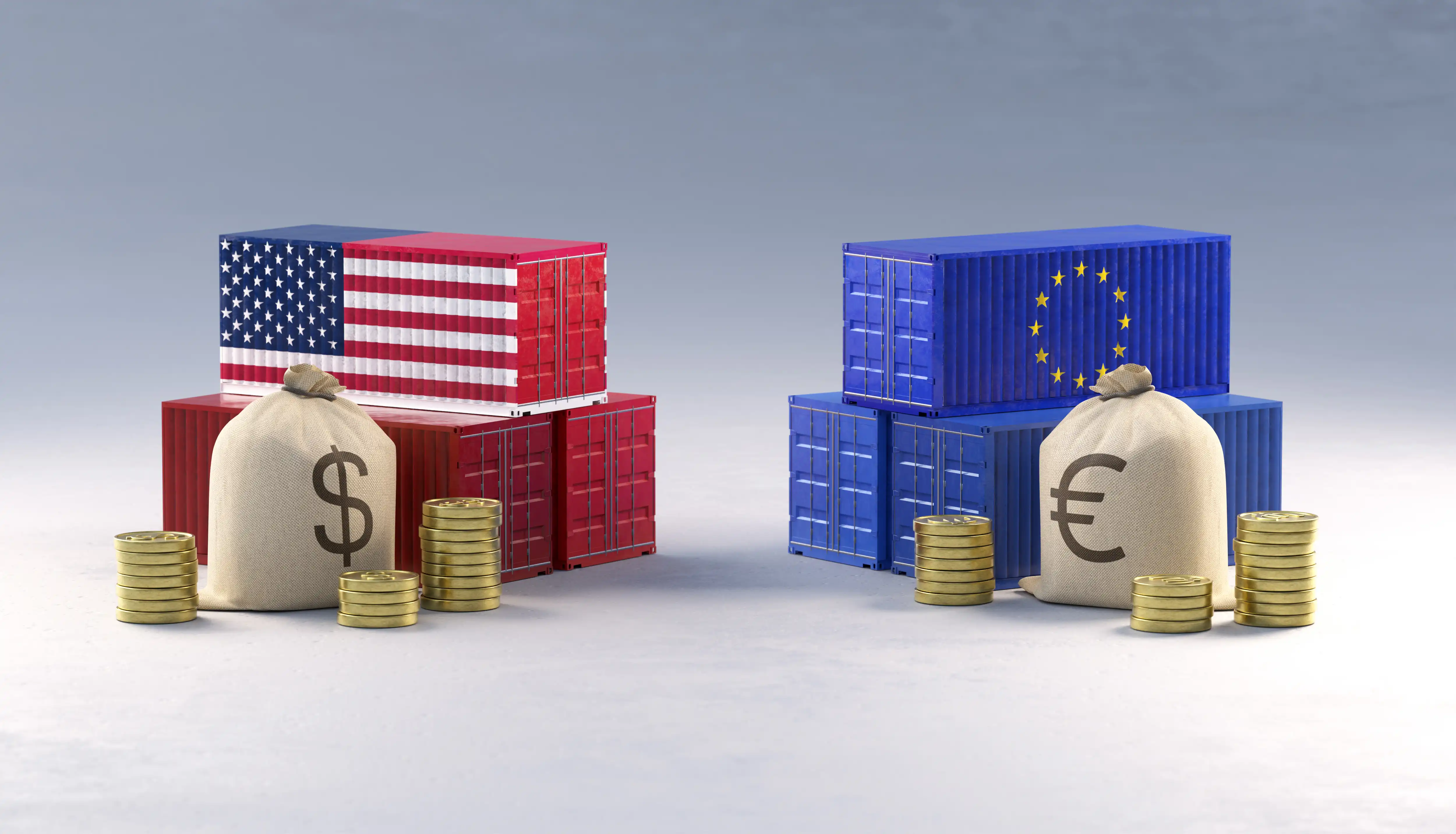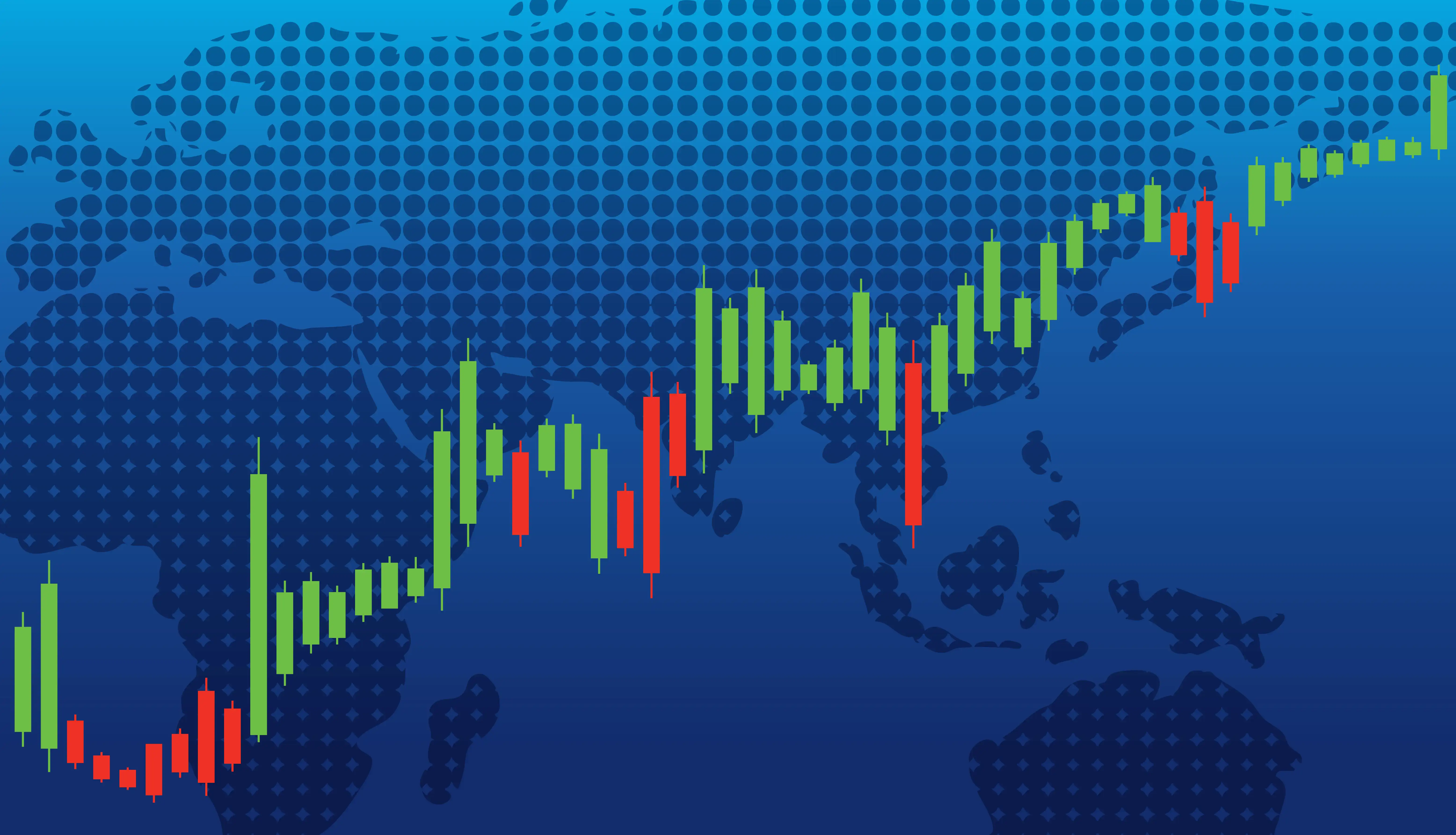EUR/GBP hovers near 0.8315 as investors await European Central Bank (ECB) President Christine Lagarde’s speech for further direction. Over the weekend, President Trump announced plans to impose 25% tariffs on steel and aluminium imports and retaliate against tariffs on countries he views as engaging in unfair trade practices. These reciprocal tariffs could significantly impact the Eurozone, which currently imposes a 10% tariff on US car imports and a 2.5% import duty on domestic vehicles. Such actions may adversely affect the Euro (EUR), which is already sensitive due to growing concerns about economic contraction and inflation falling below the ECB’s 2% target. On Monday, the Eurozone Sentix Investor Confidence Index rose to -12.7 in February, up from January’s -17.7, showing some improvement in sentiment. However, fears surrounding US tariffs continue to weigh on the Euro. In response to Trump’s threats, German Chancellor Olaf Scholz remarked that the European Union (EU) could retaliate “in an hour” if the tariffs are imposed, escalating tensions between the US and the Eurozone. Further developments in this trade war could undermine the single currency.
In addition, market sentiment is increasingly leaning towards the ECB implementing further rate reductions, adding downward pressure on the EUR. In a recent speech, ECB policymaker Boris Vujcic suggested that three more rate cuts this year are possible, though it may take until the second quarter for more concrete signs of this materialising. Sterling faces challenges from growing market speculation that the Bank of England (BoE) will also introduce rate cuts. BoE Governor Andrew Bailey stated that further rate reductions should be expected but noted that the pace will depend on economic conditions. Last week, the BoE cut interest rates by another 25 basis points, putting additional pressure on the pound.
In the absence of significant market data, the broader sentiment surrounding ECB President Lagarde’s speech is expected to drive the EUR/GBP exchange rate.

USD/CAD Buoyed Amid Trump’s Tariff Threats
USD/CAD rose to 1.4336 as the market reacted to President Trump’s recent comments. Trump reiterated his intention to impose a 25% tariff on all steel and aluminium imports without specifying the countries involved, which is expected to undermine the Canadian Dollar (CAD) as Canada is a major steel supplier to the United States. He also mentioned that additional reciprocal tariffs would be revealed midweek and implemented promptly, aligning with tariff rates set by each respective country.
Despite these concerns, stronger-than-expected employment data for January provided some relief for the Canadian economy. The Canadian labour market added 76,000 jobs in January, well above the forecasted 25,000, though still down from December’s 91,000. The unemployment rate dropped to 6.6%, better than the forecasted 6.8% and improving from the prior rate of 6.7%.
On the other hand, the US dollar faced headwinds following January’s mixed Nonfarm Payrolls (NFP) report. The US economy added 143,000 jobs, falling short of the anticipated 307,000, but the unemployment rate decreased to 4%, in line with expectations. Wage growth remained robust, with average hourly earnings rising by 0.5% month-on-month, and the annual rate climbing to 4.1%, exceeding the 3.9% forecast. The labour force participation rate improved to 62.6%, indicating resilience in employment metrics despite slower hiring trends.
With no major Canadian data due today, USD/CAD will likely be influenced by oil price movements, market reactions to Trump’s tariff proposals, and US labour market data.

AUD/JPY Lifted by BoJ Rate Hike Bets
AUD/JPY rose to near 95.66, driven by concerns that Japan may be targeted by President Trump’s trade tariffs. On Sunday, Trump announced plans to impose a 25% tariff on all steel and aluminium imports into the US, along with reciprocal duties in response to what he perceives as unfair trading practices. Additionally, hawkish expectations from the Bank of Japan (BoJ) and concerns over a potential global trade war have discouraged bearish traders from making aggressive bets on the safe-haven Japanese yen (JPY).
On Thursday, Kazuhiro Masaki, the Director General of the BoJ’s monetary affairs department, confirmed that the central bank would continue to raise interest rates if inflation accelerates towards its 2% target, creating a significant interest rate differential compared to the ECB’s dovish stance. On Friday, Gita Gopinath, First Deputy Managing Director of the IMF, stated that Japan’s services inflation remains below the 2% target, which justifies the BoJ maintaining an accommodative monetary policy. However, the IMF also cautioned Japan to stay vigilant about global market volatility, which could affect liquidity, and warned of risks from the BoJ’s rate hikes, including rising government debt servicing costs and increased corporate bankruptcy risks.
The Australian Dollar (AUD) could face difficulties amid growing concerns over the US-China trade disputes, given Australia’s strong economic ties with China. China’s Consumer Price Index (CPI) increased by 0.5% year-on-year in January, up from 0.1% in December, surpassing market expectations of 0.4%. On a monthly basis, CPI inflation rose by 0.7%, compared to a flat reading of 0% in December, although it missed the expected 0.8% rise. Meanwhile, China’s Producer Price Index (PPI) fell 2.3% year-on-year, in line with December’s decline, but weaker than the market consensus of a 2.1% decrease.
Speculation around the monetary policies of both the Bank of Japan (BoJ) and the Reserve Bank of Australia (RBA), alongside any geopolitical developments, will likely drive AUD/JPY in upcoming sessions.

EUR/USD Dampened by Fresh Trump Tariff Threats
EUR/USD traded lower near 1.0328, pressured by renewed fears of US President Trump’s tariffs. Over the weekend, Trump threatened to impose 25% tariffs on steel and aluminium imports and reciprocal tariffs on nations he deems to have unfair trade practices. These reciprocal tariffs are expected to significantly impact the Eurozone, which currently imposes a 10% tariff on US automobile imports and a 2.5% import duty on domestic cars supplied to the US. In response, French Foreign Minister Jean-Noel Barrot stated, “France and its European partners should not hesitate to defend their interests in the face of US tariff threats.” On the economic front, Germany’s Industrial Production fell 2.4% in December, missing the forecasted 0.7% decline. However, Germany’s trade surplus rose to EUR 20.7 billion, with exports up 2.9% to EUR 131.7 billion and imports increasing by 2.1%. Industrial orders surged 6.9% month-on-month but fell 6.3% year-on-year. Meanwhile, France’s trade deficit narrowed to EUR 3.9 billion in December, with exports rising by EUR 0.8 billion to EUR 51.2 billion and imports growing by EUR 0.2 billion to EUR 56.4 billion. The Eurozone Sentix Investor Confidence Index rose to -12.7 in February, up from January’s -17.7, suggesting some improvement in sentiment. The recent US NFP report revealed an increase of 143,000 jobs in January, falling short of the anticipated 170,000 and below December’s revised total of 307,000 (up from 256,000). The unemployment rate dropped to 4%, beating expectations of a steady 4.1%. Average Hourly Earnings, a key indicator of wage growth driving consumer spending, unexpectedly rose to 4.1% year-on-year, up from 3.9% in December and exceeding the expected 3.8%. On a monthly basis, Average Hourly Earnings increased by 0.5%, surpassing both the previous month’s 0.3% growth and expectations. With ECB President Christine Lagarde’s speech on the horizon, investors will focus on how Trump’s latest tariff proposals could impact the EUR/USD exchange rate.

Stay Ahead in the Currency Game
Whether you're a daily FX trader or handle international transactions regularly, our 'Currency Pulse' newsletter delivers the news you need to make more informed decisions. Receive concise updates and in-depth insights directly in your LinkedIn feed.
Subscribe to 'Currency Pulse' now and never miss a beat in the currency markets!
Ready to act on today’s insights? Get a free quote or give us a call on: +44 (0)20 7740 0000 to connect with a dedicated portfolio manager for tailored support.
Important: This blog is for informational purposes only and should not be considered financial advice. Currency Solutions does not consider individual investment goals, financial circumstances, or specific requirements of readers. We do not endorse or recommend any particular financial strategies or products discussed. Currency Solutions provides this content as is, without any guarantees of completeness, accuracy, or timeliness.
Important Disclaimer: This blog is for informational purposes only and should not be considered financial advice. Currency Solutions does not take into account the investment objectives, financial situation, or specific needs of any individual readers. We do not endorse or recommend any specific financial strategies, products, or services mentioned in this content. All information is provided “as is” without any representations or warranties, express or implied, regarding its accuracy, completeness, or timeliness.




